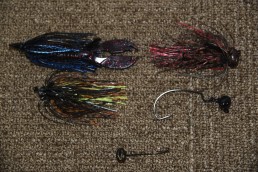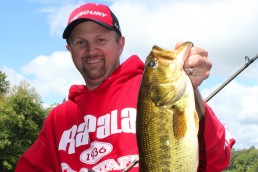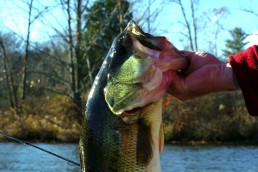Making Sense of the Many Bass Jig Options
SHARE THIS POST
Ask bass fishermen what is one of the most used baits in their tackle box and they will say crankbaits, while others will say spinnerbaits or plastic worms. But the number one answer will likely be the jig. From open water to hard water, if you are a bass fisherman, you cannot beat having a jig tied on the end of a line.
Let’s look at the most popular jigs and how to make you a better bass fisherman this season.
Swim jigs
In the last few years, swim jigs have been coming on strong. This has been a longtime secret of many pros. One of the ways to use a swim jig is go to where you can fish a spinnerbait. Here, you can fish a swim jig even better. When you are faced with an area that you cannot get a spinnerbait through without it getting fouled, you can fish a swim jig. One key to fishing a swim jig is you can swim the bait with a turn of your reel handle and on the same retrieve drop the swim jig alongside a piece of structure that bass could be hiding behind. This makes this jig such a versatile bait.
Changing the swim-jig trailer will have the biggest impact on how you can adjust the look and the action of a swim jig. One of the most popular trailer options is a single-tail grub if you’re looking to represent a baitfish, or, a double tail, if you’re looking to mimic a crawfish.
I fish my swim jig on a 7- to 7-foot 6-inch, medium-heavy baitcasting rod teamed up with a 6:4-1 speed baitcaster reel spooled with 15-pound Sunline FC Sniper line or 30-pound Sunline TX2 braided line. Make your cast, count your jig down a few feet, and then start to slowly reel. If you can get it to make contact with the cover you’re fishing in as you swim your jig back to the boat, that’s all the better. If you have a key piece of structure in your path, reel your swim jig past it a few times but also try to drop your jig alongside that cover as well to see if you can trigger a strike from a non-chasing bass.
Football jigs
This jig is designed to be fished on rocks; the shape of its head helps it from getting hung up. The football jig imitates a real craw moving along the rocks in a standup stance—that is how real craws defend themselves as they move around in the rocks.
These jigs make noise. This is what bass key on when tracking crawfish down. Also, use your football jig as a depth finder. Make your cast and let your jig settle to the bottom. Once your line goes slack, start to drag your jig along the bottom and look for rocks. When you get next to a rock, do not be too quick to move your jig on. Get your jig alongside of the stone and rock the jig back and forth a few times before you move it onto the next rock.
Trailers will play a big part in getting your bite, and when it comes to rods and reels, I use a 7-foot 6-inch flipping stick to use with many of my football jigs. I throw many football jigs at 1/2 to 1 ounce, with 3/4 and 1 getting much of my fishing time. When it comes to reels, a 6:4-1 baitcaster spooled with 15- to 20-pound-test Sunline FC Sniper line is my choice.
Are you enjoying this post?
You can be among the first to get the latest info on where to go, what to use and how to use it!
Shaky-head jigs
It all started with Elite Pro Jeff Kriet and the Squirrel Tail worm from Big Bite Baits. These have changed how we fish a jig in not only the cold waters of winter and early spring, but also every other season. Kriet mainly fished his shaky-head option during the colder months of the season, but now he fishes this option whenever he needs to get a bite.
His spinning setup consists of 7- to 7-foot 6-inch, medium-light to medium-action spinning rods teamed with a matching spinning reel. Some will prefer braided line as their main line while others will just go right straight to fluorocarbon in the 6- to 10-pound-test range depending on the conditions. For me, I run both setups and let the weather or lake pressure conditions dictate what option I use. If I’m faced with windy conditions, I’ll opt for the Sunline TX2 braid with a fluorocarbon leader. With the limited stretch factor of braid, I get more feel. If I’m faced with calmer conditions where I am not fighting the feel factor, I will go with Sunline FC Sniper fluorocarbon option in 6 to 8 pounds.
Flipping in heavy cover
Today, the majority of flipping is done with braided line. Some were having problems with bending hooks from time to time, so tackle manufacturers have responded by putting a heavier-gauge wire hook into many of the jigs they make for flipping and in heavy cover applications. Another part that’s changed has been head design. You are seeing more bullet-head designed jigs being fished for this application. Trailers will still have a big impact in how the jig fishes, so keep a close eye on what trailer you are using and what action you’re trying to get out of your jig presentation.
Some anglers are gearing toward longer rods and these are becoming the norm in many flipping, heavy-cover applications. When it comes to pitching, many are looking for 7-foot 6-inch rods. Once again, match your reel to your rod preference. More anglers are also looking toward faster speed reels to pick up line slack too.
Line choice is matched to water clarity and cover. If you are faced with dirtier water and heavy slop, you cannot beat braid. The line diameter, no-stretch properties and strength make braid your top choice when in these conditions. When faced with a pitching or flipping application and in more of an open, clear-water condition and you get bass that are line shy, a Sunline Shooter fluorocarbon is a good option. Fluorocarbon offers you low-line visibility and limited stretch, but still has better abrasion resistance to get the job done.
Swing-head jigs
Made popular in the last few years, the swing-head jigs are still trying to carve out their place in the pecking order. I have been fishing them the last few years and can say they’ve earned a spot in my jig box. I find more and more uses for them as the season goes on. The swing head is shaped like a football head jig, but does not have a fixed hook—the hook on a swing-head jig is allowed to move back and forth, giving the plastics that you put on a jig as the trailer to have more action. I fish these with craws, stickbaits and swimbaits or with plastics.
I’ll fish a swing head on a 7-foot 4-inch or 7-foot 6-inch, medium-heavy to heavy-action rod. I’ll team it up with a baitcaster spooled with 16- to 20-pound-test Sunline Sniper fluorocarbon line. Slowly reel the swing head along the bottom to keep it in constant contact with the bottom, just like you would if fishing a crankbait. The more finesse option is to drag your swing head along the bottom like you would a Carolina Rig presentation. Here, downsize your swing-head option and bait size and go to work. This option has worked well when in pressured areas or during tough cold fronts.
MWO
SHARE THIS POST
Did you enjoy this post?
You can be among the first to get the latest info on where to go, what to use and how to use it!
Scott Petersen
Scott Petersen has been writing for the past 30 years. A Minnesota native, he has a passion to fish all seasons on ice and open water. “One of my main goals is to teach people how to fish through my articles and sport-show seminars.”



